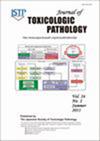睾酮对大鼠胎盘发育的影响
IF 0.9
4区 医学
Q4 PATHOLOGY
引用次数: 1
摘要
我们在多囊卵巢综合征(PCOS)大鼠模型中研究了睾酮对胎盘发育的形态学影响。丙酸睾酮(TP)从妊娠第14天(GD)至第18天以5mg/只动物的剂量皮下给药于妊娠大鼠,从第19天起诱导母体体重减轻,没有死亡或临床症状。在GD21上观察到胎儿和胎盘重量下降,宫内生长迟缓(IUGR)率增加,胎盘组织学变化,但在GD15或17上没有观察到。在GD21的组织病理学上,滋养层隔膜增厚,母体窦在迷路区变窄,形成小胎盘。此外,TP治疗组GD 21迷宫区的胎盘重量、厚度和组织学形态与对照组和TP治疗组的GD 17几乎相同。因此,假设从GD 17开始,睾酮诱导的小胎盘与胎盘胎儿部分的发育抑制有关。本文章由计算机程序翻译,如有差异,请以英文原文为准。
Effects of testosterone on rat placental development
We investigated the morphological effects of testosterone on placental development in a rat model of polycystic ovarian syndrome (PCOS). Testosterone propionate (TP), which was subcutaneously administered to pregnant rats with 5 mg/animal from gestation day (GD) 14 to GD 18, induced a maternal weight reduction without mortality or clinical signs from GD 19 onwards. A decrease in fetal and placental weight, an increase in intrauterine growth retardation (IUGR) rates, and histological changes in the placenta were observed on GD 21 but not on GD15 or 17. Histopathologically, on GD 21, the trophoblast septa thickened, and the maternal sinusoids were narrowed in the labyrinth zone, resulting in a small placenta. Additionally, the placental weight, thickness, and histological morphology in the labyrinth zone on GD 21 in the TP-treated group were nearly identical to those on GD 17 in the control and TP-treated groups. Therefore, it was assumed that the testosterone-induced small placenta was induced in association with the developmental inhibition of the fetal part of the placentas from GD 17 onwards.
求助全文
通过发布文献求助,成功后即可免费获取论文全文。
去求助
来源期刊

Journal of Toxicologic Pathology
PATHOLOGY-TOXICOLOGY
CiteScore
2.10
自引率
16.70%
发文量
22
审稿时长
>12 weeks
期刊介绍:
JTP is a scientific journal that publishes original studies in the field of toxicological pathology and in a wide variety of other related fields. The main scope of the journal is listed below.
Administrative Opinions of Policymakers and Regulatory Agencies
Adverse Events
Carcinogenesis
Data of A Predominantly Negative Nature
Drug-Induced Hematologic Toxicity
Embryological Pathology
High Throughput Pathology
Historical Data of Experimental Animals
Immunohistochemical Analysis
Molecular Pathology
Nomenclature of Lesions
Non-mammal Toxicity Study
Result or Lesion Induced by Chemicals of Which Names Hidden on Account of the Authors
Technology and Methodology Related to Toxicological Pathology
Tumor Pathology; Neoplasia and Hyperplasia
Ultrastructural Analysis
Use of Animal Models.
 求助内容:
求助内容: 应助结果提醒方式:
应助结果提醒方式:


